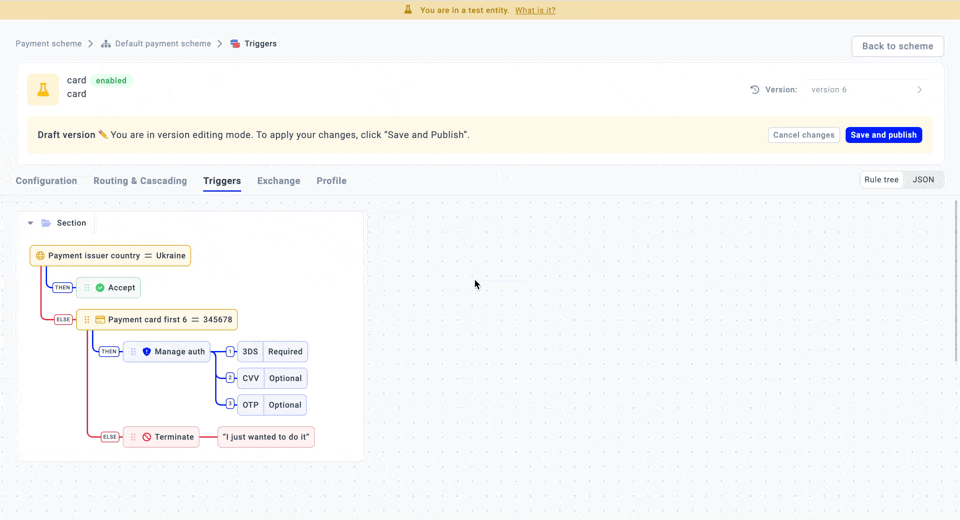Review Triggers actions & Cascading
Trigger scheme is a combination of conditions that step before the Routing and cover the additional Rules that should be followed to sustain the payment process.
To be more precise, we consider Triggers as a set of condition-trigger bindings. The value of the condition key must be an object of a structure similar to the condition structure from the Routing scheme. If the condition is met, the Trigger is activated.
Choose Triggers strategy
| Trigger strategy → switched on | Description |
| Manage Auth |
You can set the additional authentication on the Triggers scheme as a separate layer of security if needed.
After setting up the preconditions, the Trigger scheme should react accordingly before the Routing stage. |
| List interaction | You can add a particular transaction to a list to be able to store the valuable data if necessary.
|
| Accept | The action approves the Request and allows the payment flow to continue functioning at the Routing level. |
| Terminate | The action stops the payment flow and blocks the process before initiating the Routing. You can set a specific Resolution explaining the reason for the termination.
|
Set up Actions cascading
The Actions cascading principle is quite similar to the one you set up for Routing and Cascading. While dealing with multiple Trigger rules, it is useful to divide the complex conditions into smaller ones and establish the correct flow if the first given condition does not serve the valid outcome. The main goal of such a feature is to incorporate the additional Rules before the Routing part takes in but with minimum risks involved.
Be aware!When you choose the Terminate action, it automatically stops the process even if several attempts are left to fulfil.
How does it work on a higher level?
- You can establish a series of steps that should be taken consecutively.
- The system should automatically proceed to the following action if the first isn't feasible until it discovers one that can be carried out.
- Actions cascading work similarly to the By Priority Routing strategy.
Use Drag-and-drop for Trigger rules and Actions
Drag-and-drop functionality allows you to reorder Trigger rules and Actions according to your needs. Thus, you do not need to establish a new Trigger scheme for rearrangements.
- Go to the Triggers tab of the particular Payment method.
- Select the Rule or Action you want to drag and move it in the appropriate direction.
- Click Save and publish. The system should create a new Version of Routing that can be used or modified further. To learn more about Versions, go to the Discover Versions guide.

Review options in JSON editor
You can use the JSON editor to review and update the Trigger scheme under the hood.
- Go to the Triggers tab of the particular Payment method.
- Switch from the Rule tree to the JSON editor.
- Review the Trigger scheme in the JSON format and make changes accordingly.
- You can also import and export the data as necessary.
Pay attention!When the Scheme structure is lost, you cannot save the changes.

Updated 10 days ago
